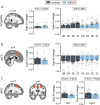Targeting working memory to modify emotional reactivity in adult attention deficit hyperactivity disorder: a functional magnetic resonance imaging study
- PMID: 34524649
- PMCID: PMC9010388
- DOI: 10.1007/s11682-021-00532-6
Targeting working memory to modify emotional reactivity in adult attention deficit hyperactivity disorder: a functional magnetic resonance imaging study
Abstract
Understanding the neural mechanisms of emotional reactivity in Attention-Deficit/Hyperactivity Disorder (ADHD) may help develop more effective treatments that target emotion dysregulation. In adult ADHD, emotion regulation problems cover a range of dimensions, including emotional reactivity (ER). One important process that could underlie an impaired ER in ADHD might be impaired working memory (WM) processing. We recently demonstrated that taxing WM prior to the exposure of emotionally salient stimuli reduced physiological and subjective reactivity to such cues in heavy drinkers, suggesting lasting effects of WM activation on ER. Here, we investigated neural mechanisms that could underlie the interaction between WM and ER in adult ADHD participants. We included 30 male ADHD participants and 30 matched controls. Participants performed a novel functional magnetic resonance imaging paradigm in which active WM-blocks were alternated with passive blocks of negative and neutral images. We demonstrated group-independent significant main effects of negative emotional images on amygdala activation, and WM-load on paracingulate gyrus and dorsolateral prefrontal cortex activation. Contrary to earlier reports in adolescent ADHD, no impairments were found in neural correlates of WM or ER. Moreover, taxing WM did not alter the neural correlates of ER in either ADHD or control participants. While we did find effects on the amygdala, paCG, and dlPFC activation, we did not find interactions between WM and ER, possibly due to the relatively unimpaired ADHD population and a well-matched control group. Whether targeting WM might be effective in participants with ADHD with severe ER impairments remains to be investigated.
Keywords: Adult Attention-Deficit/Hyperactivity Disorder (ADHD); Emotional dysregulation; Emotional reactivity; Functional magnetic resonance imaging (fMRI); Working memory.
© 2021. The Author(s).
Conflict of interest statement
None of the authors reported biomedical financial interests or potential conflicts of interest.
Figures




References
-
- American Psychiatric Association. (2000). Diagnostic and statistical manual of mental disorders (4th ed., Text Revision). Washington, DC.
-
- Barkley RA, Fischer M. The unique contribution of emotional impulsiveness to impairment in major life activities in hyperactive children as adults. Journal of the American Academy of Child and Adolescent Psychiatry. 2010;49(5):503–513. - PubMed
MeSH terms
LinkOut - more resources
Full Text Sources
Medical

